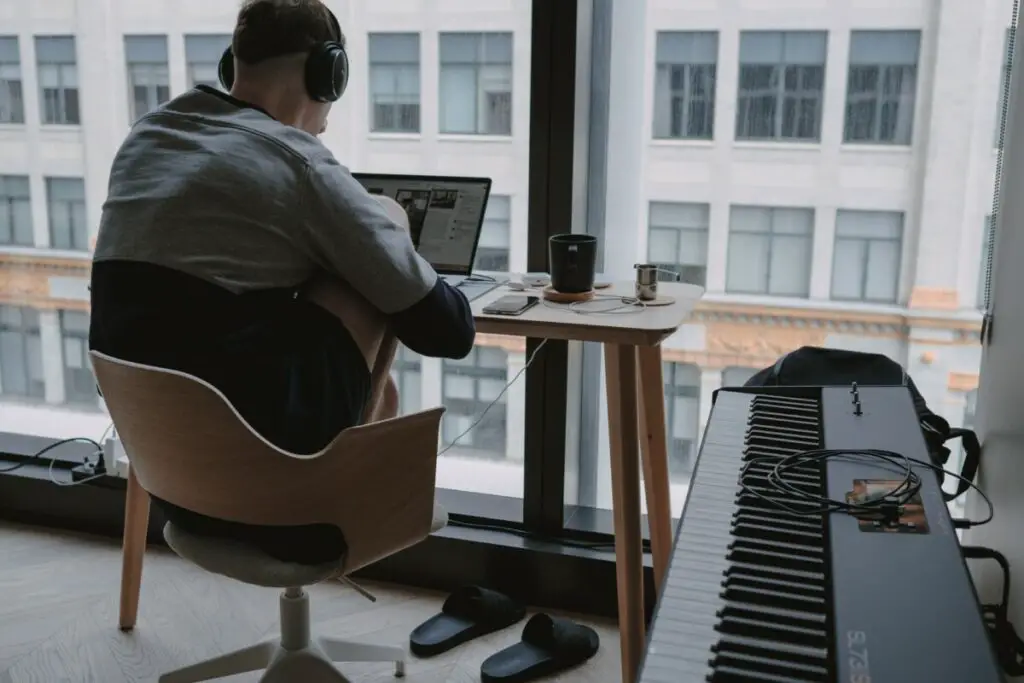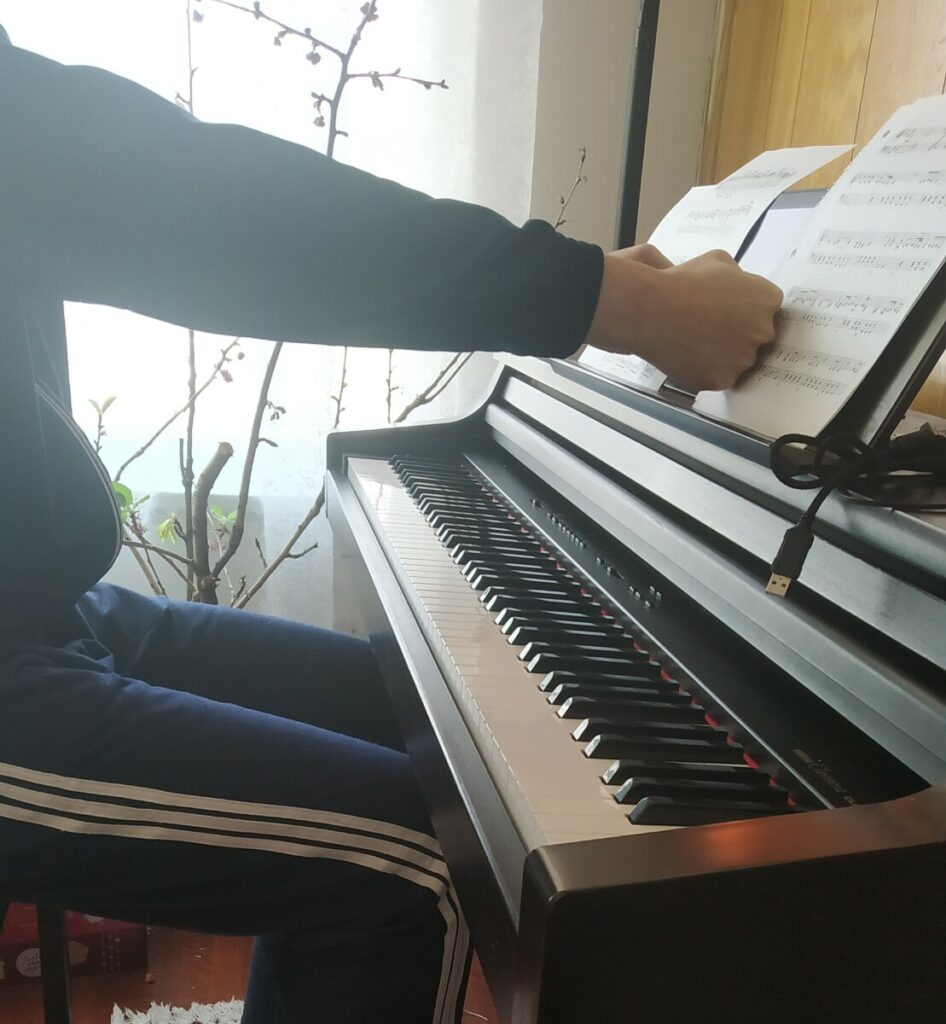This post contains affiliate links.

Is a piano bench necessary or can I use my office chair to play the piano? What are the benefits of a bench? These questions may have crossed your mind as you are thinking of buying a piano or starting to play the piano. There are debates on this topic, but:
As a general rule, a piano bench isn’t necessary to play the piano, the more important factor is whether or not your chair is height-adjustable and the seat is flat, parallel to the floor.
However, a piano bench is specifically designed for piano players and has many great benefits to offer to its users.
Purposes of piano benches
Piano benches are designed to give better support and control when playing loud forte and quiet piano passages in a piece that requires effective movement of your body, or when you need to lean towards the piano to hit the keys on different sections of the piano.
Sitting at the correct height to the piano is crucial because you’ll gain the most optimal fingers’ positions to play piano effectively. Benches that come with the pianos or height-adjustable ones enable you to do this.
Furthermore, some models of the benches can store things within them, making it very convenient to store piano sheets, and not having them laying on top of your piano, making a mess out of it.
Besides, a dedicated piano bench is no doubt more aesthetically pleasing and suitable compared to a swivel chair in front of a piano.
Can I use a swivel office chair to play piano?
While it’s very convenient when your piano is next to your workstation, where you can switch to playing piano while taking a break from working by dragging your swivel chair a short distance, the swivelling of the chair causes you to be in slightly different positions while playing, making your brain to do unnecessary work to adjust get used to it.
However, you may enjoy being able to rest your back on your office chair when you stop playing, not having to sit straight all the time like on the bench, which is valid since being comfy is also important when playing, especially when you might spend a couple of hours per day playing on a chair.
As a rule of thumb, if you’re using chairs to play the piano, make sure:
- The chair is armless since chairs with arms can hinder movements of your own arms.
- The seat is flat and parallel to the ground.
- The height is right and consistent with the piano.

Why do benches have no back?
This forces you to sit straight since it’s the best form when playing the piano, having something to lean back towards means that your arms are further away from the piano, and you can’t play like that! This may feel uncomfortable but it ensures you have the best position to play the piano.
Correct form when sitting on a bench
Don’t sit too close to the piano because your hands may hit each other as you’re playing if you sit too close.
Make sure you don’t sit such that the front edge of the bench touches the back of your knees, only use half of the seat since this will make it easier to lean and hit the keys on different areas of the keyboard.

So how far should you be from the piano? Create fists out of your hands. An arm’s length from where you’re sitting to where your piano sheet is generally a good distance to be.

The most important factor is to have the correct height when playing. Too low and you’ll have a harder time hitting notes due to not being able to use the weights of your arms and let gravity do the work. Too high and your fingers are at an awkward angle to play.
The right height is where your forearms are straight, perpendicular to the front of the piano.
Types of benches
- Duet style bench: most common type of bench. It’s called duet since two people can sit side by side. This type of bench is beneficial to students when their teachers want to sit next to them to practice duets or fix mistakes.
- Artist bench (tabouret): suitable for more advanced piano players because it’s height-adjustable, which is very important when playing, along with being more comfortable to sit on.
- Double wide artist bench: the best of both worlds, it’s more on the expensive side but it’s worth the money since you can benefit from a wider surface area to sit on and being height-adjustable.
- Foldable benches: this type is usually seen being used with electric keyboards or digital pianos. Its legs cross each other to make an X shape. Foldable benches are lightweight, making it highly mobile, easy to carry and easy to store. It’s also generally cheaper than the other options.
- Piano chairs (comes with older Steinway pianos): looks like an ordinary chair but is slanted to lean towards the piano. This makes it more comfortable to play and causes less fatigue on the back.
Can a foldable bench be used with an upright or grand piano?
Surely, a cheap foldable bench isn’t going to look the part in front of an upright or grand piano. However, if it’s not for performance purposes, the most important thing is that you are comfortable and that the bench can be adjusted to the correct height.
Do benches come with pianos?
Most of the time, a purchase of a piano – digital or acoustic – will include a bench with it. Benches for consumer-grade pianos are made by the piano manufacturer and are included with the pianos. Benches for performance-grade pianos are offered separately by the dealer.
However, if you’re buying an electric keyboard, a bench may not be included and you have to buy one separately.
Factors to look for when buying a piano bench
- Comfort: an important factor to consider since you may be spending a couple of hours per day practicing piano. If possible, go to a piano store to test the comfiness of the benches offered in person.
- Posture: recall from above that the best posture to have is where you’re an arm’s length from the piano sheet, you’re using only half of the seat and the height of the seat is such that your forearms are perpendicular to the front of the piano. This makes the height-adjustable aspect of a bench worthy of consideration.
- Stability: you might think of skipping this in order to cut costs. Think twice about it, because nothing is more annoying than playing on a wobbly bench. Height-adjustable benches usually have bolts to tighten to make them more stable.
- Convenience: you could go for benches with storage inside of them.
Piano benches for children
A good posture when playing is crucial to a child’s success at the piano. So it’s better to invest in a bench from the beginning instead of using a normal chair to make sure your child develops the best posture from the start, not having to fix it in the future.
If your bench isn’t height-adjustable, use books the elevate your child, making sure their forearms are perpendicular to the front of the piano.
If your child isn’t tall enough to put their feet on the ground when sitting on a bench, consider using a pedal extender so they can use the pedals of the piano.


